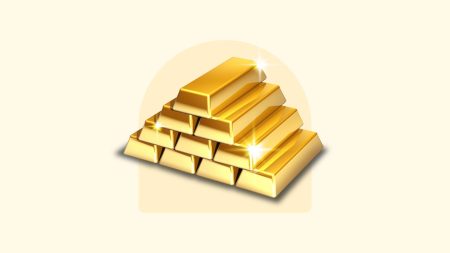Ever wondered how long it’ll take to double your money with interest? The Rule of 72 is a simple trick to get a ballpark estimate.
What is the Rule of 72?
Here’s how it works: Divide 72 by your expected annual interest rate (as a percentage, not a decimal). The answer is roughly the number of years it will take for your money to double.
For example, if your investment earns 4 percent a year, it would take about 72 / 4 = 18 years to double.
This rule can also be used for inflation. Just like with investment growth, divide 72 by the inflation rate (again, as a percentage) to estimate how many years it’ll take for your money’s buying power to get cut in half.
The Rule of 72 is an estimate, and more accurate at around 8 percent interest. The further the interest rate or inflation rate is from 8 percent, the less precise the result will be.
Despite its limitations, the Rule of 72 is a handy tool for getting a quick sense of how your money might grow over time, considering a certain interest rate.
The formula for the Rule of 72
The Rule of 72 can be expressed simply as:
Years to double = 72 / rate of return on investment (or interest rate)
There are a few important caveats to understand with this formula:
- The interest rate shouldn’t be expressed as a decimal out of 1, such as 0.07 for 7 percent. It should just be the number 7. So, for example, 72/7 is 10.3, or 10.3 years.
- The Rule of 72 is focused on compounding interest that compounds annually.
- For simple interest, you’d simply divide 1 by the interest rate expressed as a decimal. If you had $100 with a 10 percent simple interest rate with no compounding, you’d divide 1 by 0.1, yielding a doubling rate of 10 years.
- For continuous compounding interest, you’ll get more accurate results by using 69.3 instead of 72. The Rule of 72 is an estimate, and 69.3 is harder for mental math than 72, which divides easily by 2, 3, 4, 6, 8, 9 and 12. If you have a calculator, however, use 69.3 for slightly more accurate results.
- The farther you diverge from an 8 percent return, the less accurate your results will be. The Rule of 72 works best in the range of 5 to 10 percent, but it’s still an approximation. To calculate based on a lower interest rate, like 2 percent, drop the 72 to 71. To calculate based on a higher interest rate, add one to 72 for every 3 percentage point increase. So, for example, use 74 if you’re calculating doubling time for 16 percent interest.
How the Rule of 72 works
The actual mathematical formula is complex and derives the number of years until doubling based on the time value of money.
You’d start with the future value calculation for periodic compounding rates of return, a calculation that helps anyone interested in calculating exponential growth or decay. FV is future value, PV is present value, r is the rate and the t is the time period.
FV = PV*(1+r)t
To isolate t when it’s located in an exponent, you can take the natural logarithms of both sides. Natural logarithms are a mathematical way to solve for an exponent. A natural logarithm of a number is the number’s own logarithm to the power of e, an irrational mathematical constant that is approximately 2.718. With the example of a doubling of $10, deriving the Rule of 72 would look like this:
20 = 10*(1+r)t 20/10 = 10*(1+r)t/10 2 = (1+r)t ln(2) = ln((1+r)t) ln(2) = r*t
The natural log of 2 is 0.693147, so when you solve for t using those natural logarithms, you get t = 0.693147/r.
The actual results aren’t round numbers and are closer to 69.3, but 72 easily divides for many of the common rates of return that people get on their investments, so 72 has gained popularity as a value to estimate doubling time.
For more precise data on how your investments are likely to grow, use a compound interest calculator that’s based on the full formula.
How to use the Rule of 72 for your investment planning
Most families aim to continue investing over time, often monthly. You can project how long it takes for your compound interest investment to get to a given target amount if you have an average rate of return and a current balance.
If, for example, you have $100,000 invested today at 10 percent interest, and you are 22 years away from retirement, you can expect your money to double approximately three times, going from $100,000 to $200,000, then to $400,000, and then to $800,000.
If your interest rate changes or you need more money because of inflation or other factors, use the results from the Rule of 72 to help you decide how to keep investing over time.
You can also use the Rule of 72 to make choices about risk versus reward. If, for example, you have a low-risk investment that yields 2 percent interest, you can compare the doubling rate of 36 years to that of a high-risk investment that yields 10 percent and doubles in seven years.
Young adults often gravitate toward higher-risk investments due to the potential for exponential growth. With a longer time horizon, they can ride out market fluctuations and potentially benefit from multiple periods of doubling their money. That’s why stocks are considered one of the best investments for college students and other young adults.
However, as people get closer to retirement, their investment strategy typically shifts. The focus goes from high returns to capital preservation. Since their time frame shrinks, doubling their money becomes less important. Instead, they prioritize the security of their nest egg by choosing lower-risk investments. This ensures they have a predictable and stable source of income later in life.
Rule of 72 during inflation
Investors can use the Rule of 72 to see how many years it will take to cut in half their purchasing power due to inflation. For example, inflation is currently around 3 percent. You can divide 72 by the rate of inflation to get 24 years until the purchasing power of your money is reduced by 50 percent. High inflation, like the 8 percent rate we saw in 2022, drops the time to half to nine years though.
72/3 = 24 years to lose half your purchasing power 72/8 = 9 years
The Rule of 72 helps investors grasp the real-world impact of inflation. While inflation may not always stay high, history shows periods where it persisted for years, significantly eroding the buying power of savings.
Bottom line
The Rule of 72 is a valuable tool for anyone starting their investment journey. It highlights the importance of early investing, even with smaller amounts. The power of compounding interest allows your money to grow exponentially over time, especially the more you invest initially. You can also use the Rule of 72 to understand inflation’s impact. By dividing 72 by the inflation rate, you can estimate how many years it takes for your money’s buying power to be cut in half.
Note: Laura Leavitt contributed to this story.
Read the full article here










